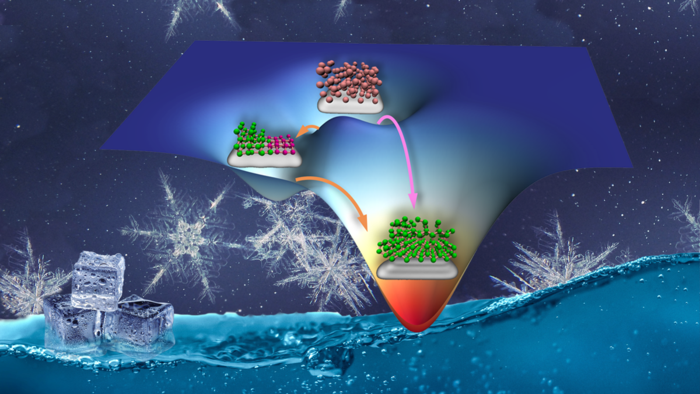Reviewed by Alex SmithAug 18 2021
Ice is ubiquitous and greatly impacts human’s routine life, affecting aspects such as transportation, climate change and energy consumption. Gaining better insights into the ice formation process can reduce the rate of glacial melting and sea-level rise and mitigate other key environmental concerns.
 Ice nucleation on foreign surfaces can proceed via both one-step (magenta arrow) and two-step (orange arrows) pathways, facilitated by the balanced synergetic, entropic effects of hexagonal (green spheres) and rhombic (purple spheres) ice structures. Image Credit: The Hong Kong University of Science and Technology.
Ice nucleation on foreign surfaces can proceed via both one-step (magenta arrow) and two-step (orange arrows) pathways, facilitated by the balanced synergetic, entropic effects of hexagonal (green spheres) and rhombic (purple spheres) ice structures. Image Credit: The Hong Kong University of Science and Technology.
The ice formation is majorly governed by ice nucleation caused by the growth of the nuclei. This made the scientists dedicate more work to learn the kinetics and thermodynamics underlying the nucleation processes.
Ice nucleation can happen in two different ways: heterogeneously on the surface of a solid material or homogeneously in bulk water. In this context, heterogeneous ice nucleation (HIN) is the major process of ice formation on the Earth. Yet, unlike homogeneous ice nucleation, the water-surface interaction occurring in HIN transforms the nucleation process sensitive to surface properties.
Comprehending the way in which surfaces affect the nucleation process is a reliable method to effectively predict and regulate crystallization processes.
A general model employed to determine nucleation kinetics depending on the thermodynamics framework, called classical nucleation theory (CNT), proposes that water molecules must build into an ice nucleus of critical size before the occurrence of the crystallization process.
The formation of a critical ice nucleus is linked with a single free energy barrier that must be overcome to induce additional ice growth. However, years of simulations and experiments have uncovered that CNT is often insufficient to explain a few complicated nucleation processes. At the same time, CNT was under deep discussion, and non-classical nucleation theories have been proposed alternatively.
Unlike CNT, which involves overcoming a single free energy barrier, non-classical nucleation theories propose that nucleation processes comprise two or more levels isolated by multiple free energy barriers.
Non-classical nucleation seems to be a more sustainable model, but the atomistic processes and structural evolutions during the formation of the nucleus in non-classical nucleation pathways are not so familiar. This has been difficult to unravel through experimental methods.
For the first time, a research group at Hong Kong University of Science and Technology (HKUST) headed by Professor Xuhui Huang from the Department of Chemistry integrated Markov State Models (MSMs) and transition path theory (TPT) to explain the ensemble pathways of HIN. The MSMs model long-timescale dynamics of chemical molecules and TPT explains the reaction pathways of rare events.
MSMs trace the intermediate states of disordered ice mixtures and put parallel pathways (classical versus non-classical) in comparison. This benefit enabled the researchers to unravel the basic mechanisms of the co-existence of the two pathways and non-classical nucleation processes.
The scientists demonstrated that the disorganized mixing of ice stabilizes the critical nucleus and makes the non-classical nucleation pathways as accessible as the classical pathway. Here, the critical nucleus majorly consists of potential energy-favored ice.
The researchers also found that at high temperatures, the nucleation process chooses to continue through the classical pathway because of the potential energy contributions that enable the classical pathway to remain.
Not only does our work uncover the mechanisms of non-classical nucleation processes, but it also demonstrates how the combination of MSMs and TPT offers a powerful framework to study structural evolutions of ice nucleation processes.
Xuhui Huang, Research Lead and Professor, Department of Chemistry, Hong Kong University of Science and Technology
“More importantly, this method can be extended to other crystal nucleation processes that are challenging to study, which will open new doors for scientists attempting to predict and control crystallization processes,” added Huang.
The first author of this study is Dr. Chu Li, a long-time HKUST affiliate who completed his PhD and currently performs his post-doctoral training at HKUST.
Journal Reference:
Li, C., et al. (2021) Temperature-dependent kinetic pathways of heterogeneous ice nucleation competing between classical and non-classical nucleation. Nature Communications. doi.org/10.1038/s41467-021-25267-2.